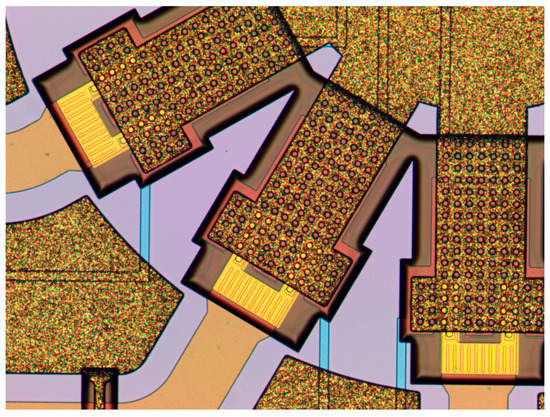Modelling, Validation and Experimental Analysis of Diverse RF-MEMS Ohmic Switch Designs in View of Beyond-5G, 6G and Future Networks—Part 1
Abstract
1. Introduction
2. RF-MEMS Switch Design Concepts
3. Experimental Validation of the RF Characteristics
4. Comparison of the Four RF-MEMS Switches Performance over Frequency
5. Conclusions
- Extensive validation of the prediction accuracy achieved by the FEM-based simulation methodology, based on the comparison against Scattering parameter (S-parameters) experimental datasets of the four RF-MEMS designs;
- Comparison of the RF performances of the four studied design concepts, highlighting pros and cons of each solution, having in mind the emerging needs of 6G and FN;
- Introduction of ad hoc metrics to help compare in a quantitative fashion the spread of simulations vs. measurements and, more generally, of two S-parameter traces that need to be evaluated against each other.
Funding
Institutional Review Board Statement
Informed Consent Statement
Data Availability Statement
Conflicts of Interest
Appendix A
| Acronym | Meaning |
|---|---|
| DA | Device A |
| DB | Device B |
| DC | Device C |
| DD | Device D |
| C | Close |
| O | Open |
| M | Measurement |
| S | Simulation |
| P1 | Port 1 |
| P2 | Port 2 |
| PMD | Percent Magnitude Difference |
| PPD | Percent Phase Difference |
| Plot Label | Displayed Plot Content |
|---|---|
| a | S11 [dB]—Reflection (if Open)/Return loss (if Close) at Port 1 |
| b | S21 [dB]—Isolation (if Open)/Insertion loss (if Close) at Port 2 |
| c | S12 [dB]—Isolation (if Open)/Insertion loss (if Close) at Port 1 |
| d | S22 [dB]—Reflection (if Open)/Return loss (if Close) at Port 2 |
| e | Phase [deg] of S11 (Port 1) |
| f | Phase [deg] of S21 (Port 2) |
| g | Phase [deg] of S12 (Port 1) |
| h | Phase [deg] of S22 (Port 2) |
| i | Difference of S11 and S21 measured and simulated magnitude |
| j | Difference of S12 and S22 measured and simulated magnitude |
| k | Difference of S11 and S21 measured and simulated phase |
| l | Difference of S12 and S22 measured and simulated phase |
| m | PMD [%] of S11 and S21 |
| n | PMD [%] of S12 and S22 |
| o | PPD [%] of S11 and S21 |
| p | PPD [%] of S12 and S22 |
| q | Smith chart plot of S11 |
| r | Smith chart plot of S21 |
| s | Smith chart plot of S12 |
| t | Smith chart plot of S22 |
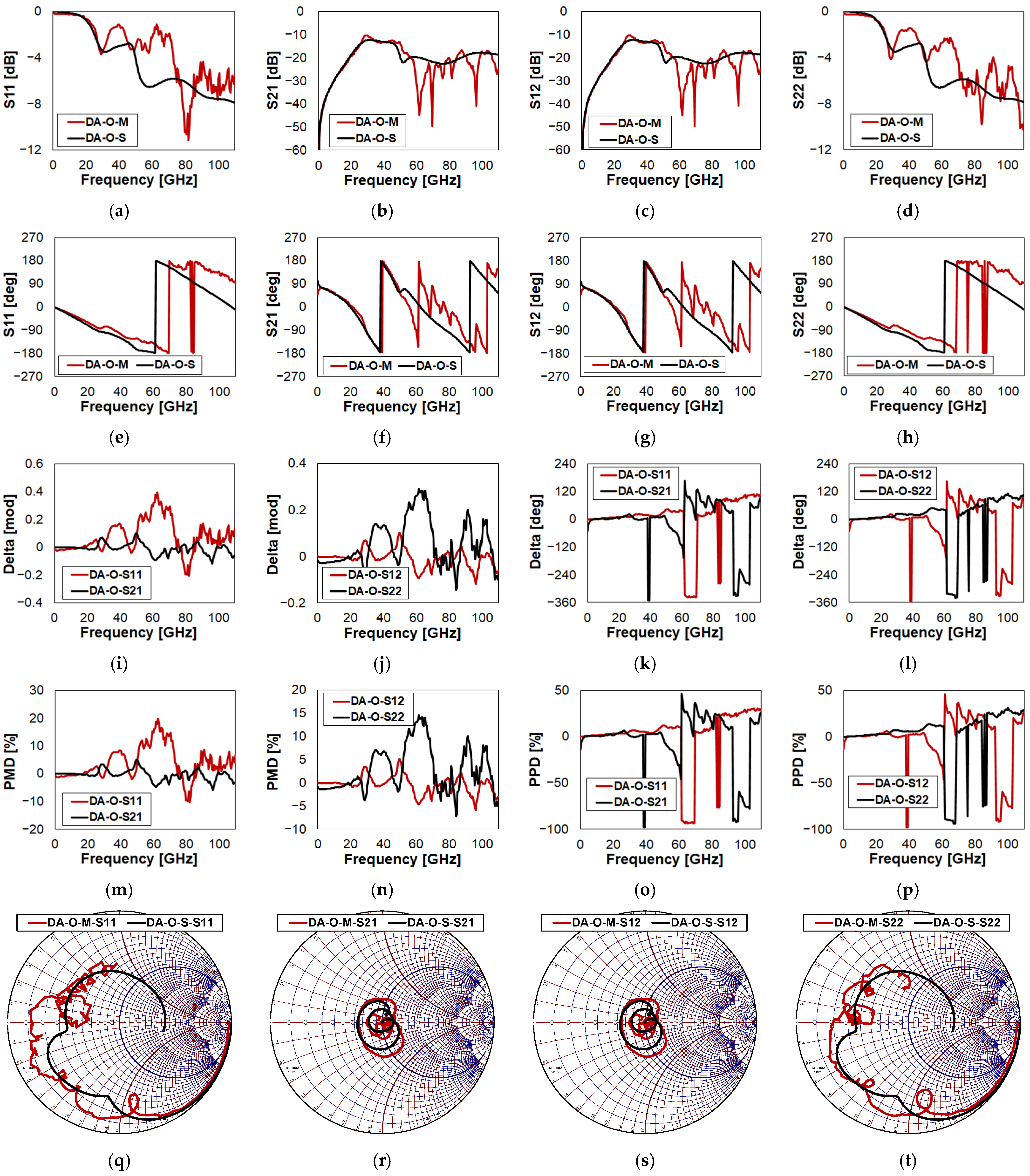
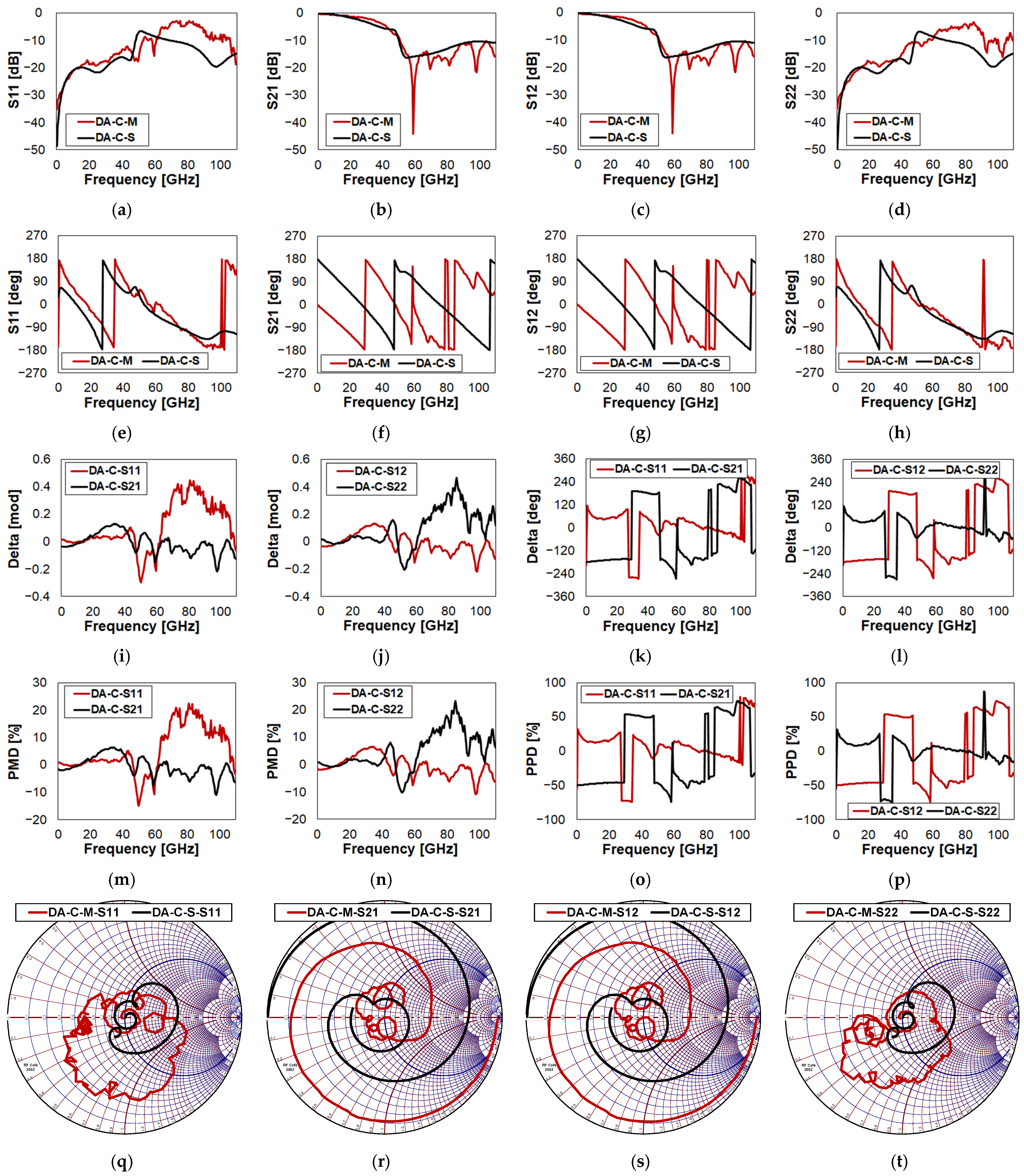
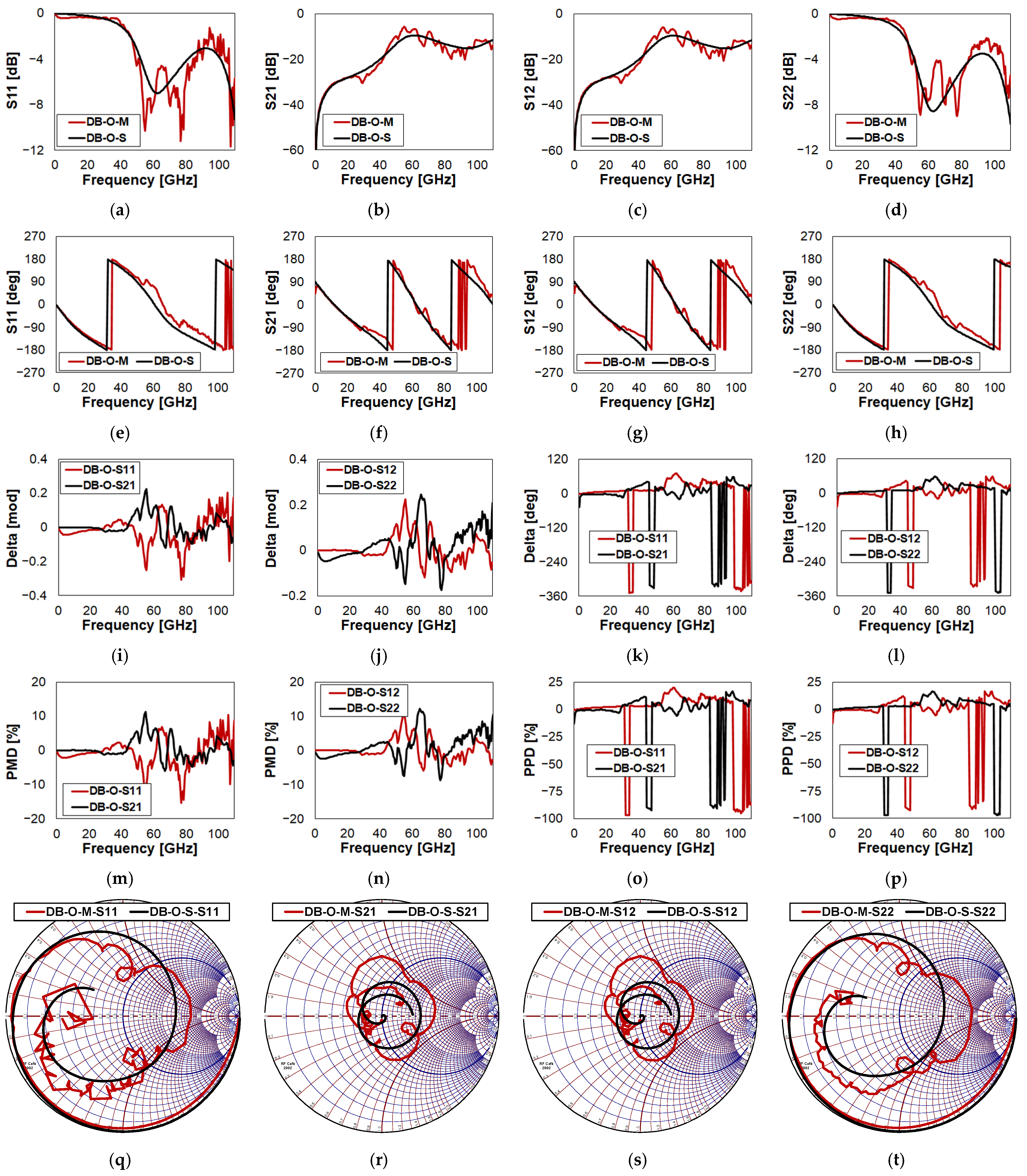

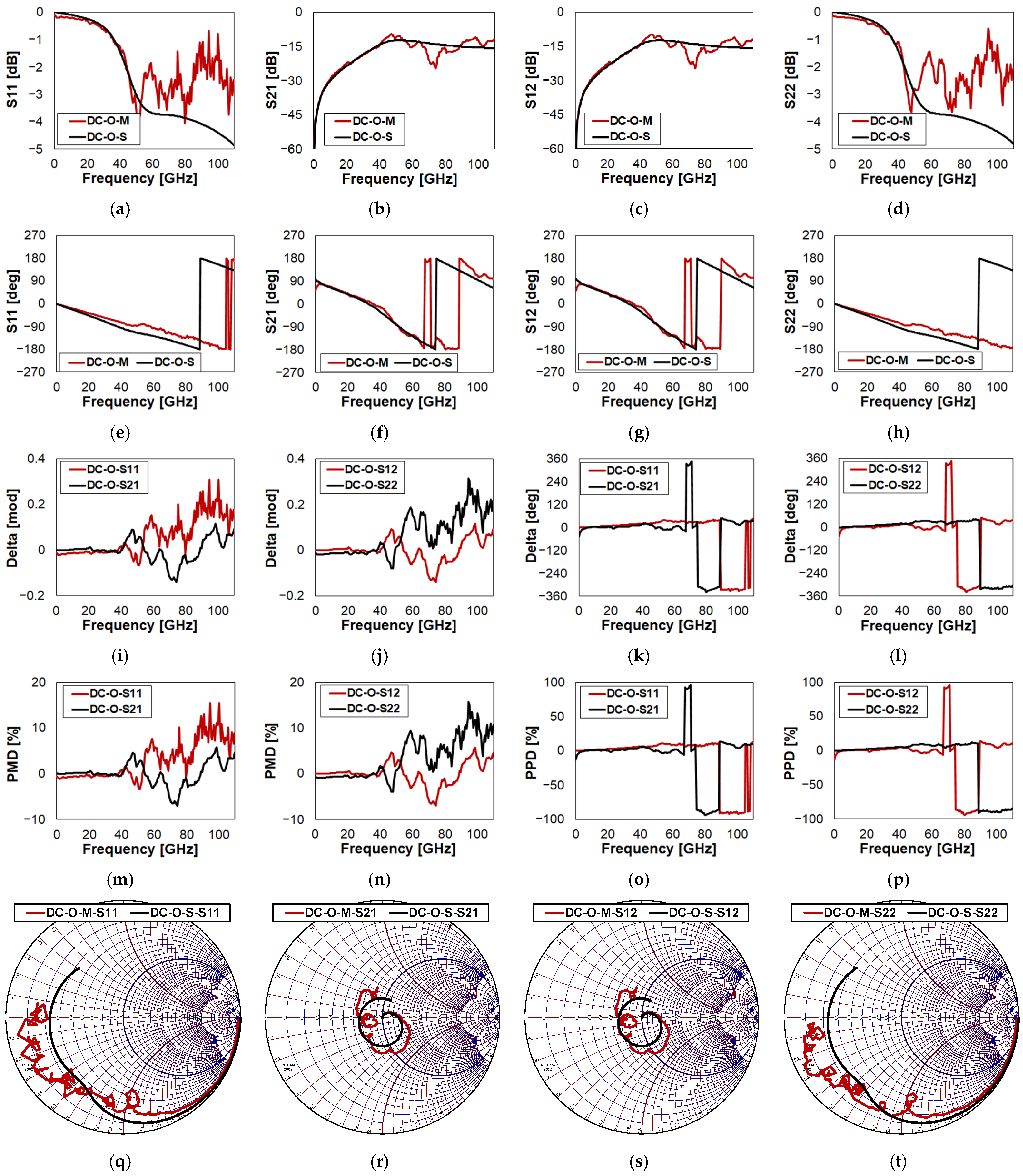


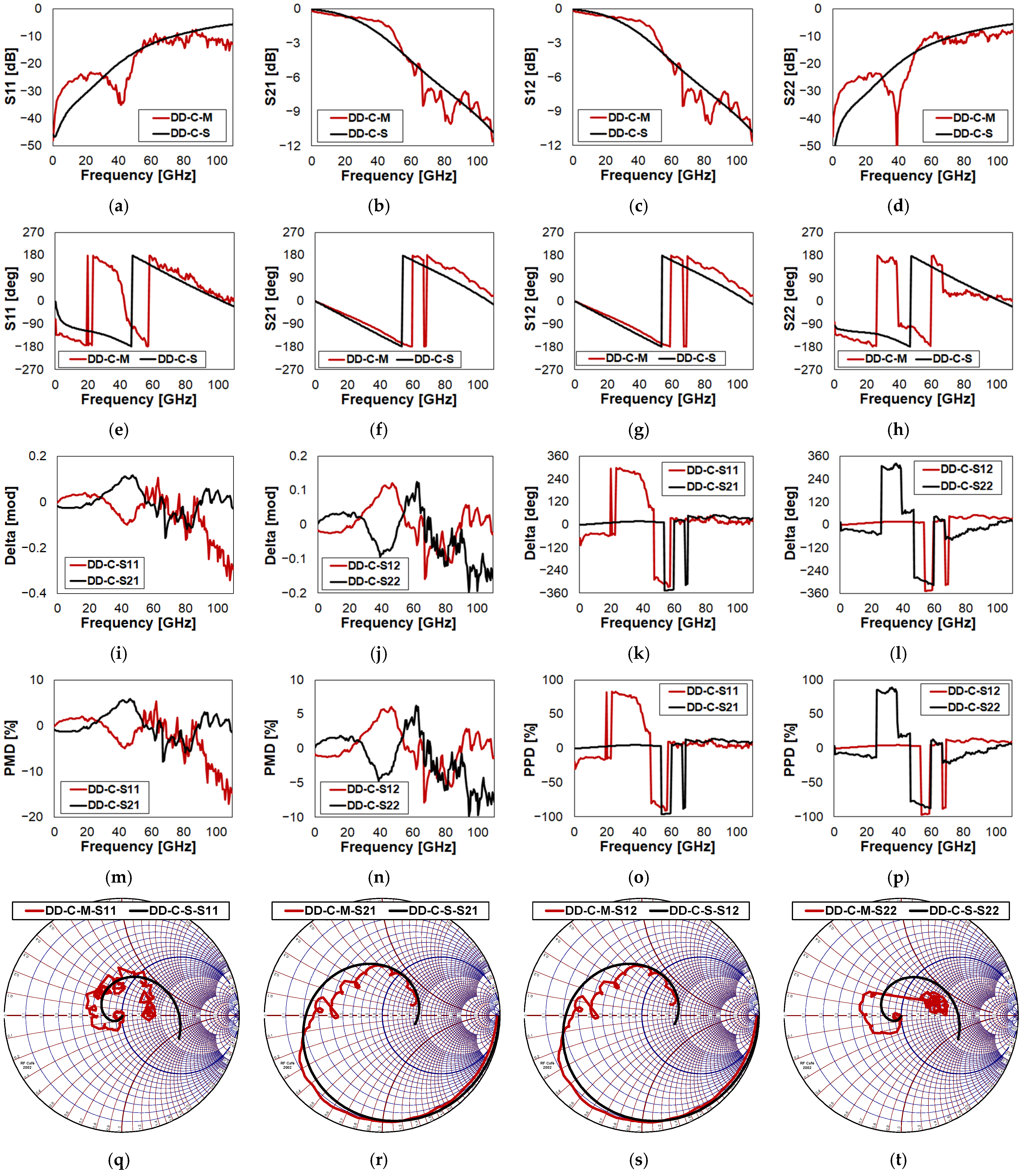
Appendix B

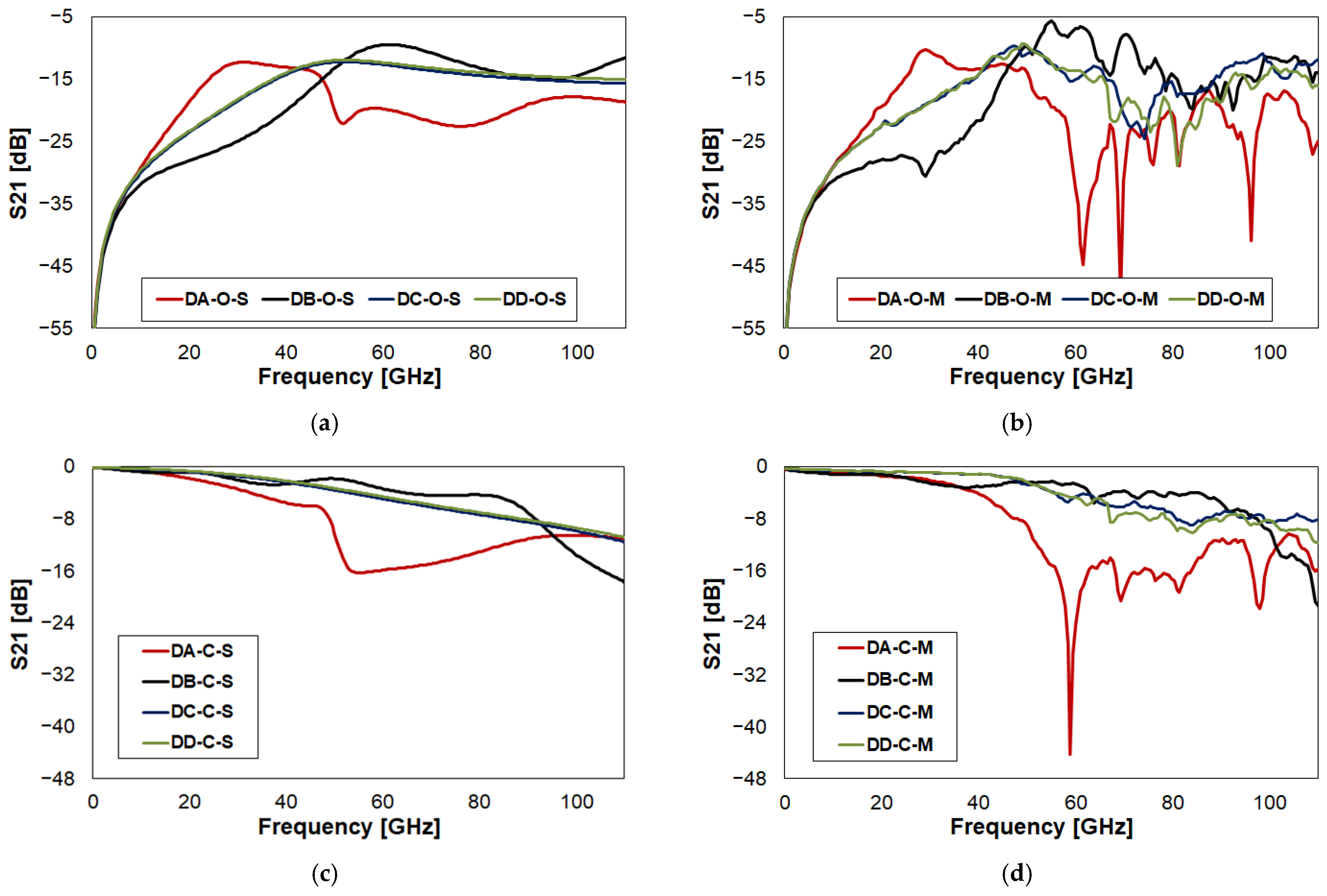
References
- Zhang, C.; Ueng, Y.L.; Studer, C.; Burg, A. Artificial Intelligence for 5G and beyond 5G: Implementations, Algorithms, and Optimizations. IEEE J. Emerg. Sel. Top. Circuits Syst. 2020, 10, 149–163. [Google Scholar] [CrossRef]
- You, X.; Wang, C.X.; Huang, J.; Gao, X.; Zhang, Z.; Wang, M.; Huang, Y.; Zhang, C.; Jiang, Y.; Wang, J.; et al. Towards 6G Wireless Communication Networks: Vision, Enabling Technologies, and New Paradigm Shifts. Sci. China Inf. Sci. 2021, 64, 110301. [Google Scholar] [CrossRef]
- Iannacci, J.; Poor, H.V. Review and Perspectives of Micro/Nano Technologies as Key-Enablers of 6G. IEEE Access 2022, 10, 55428–55458. [Google Scholar] [CrossRef]
- Weller, T.M.; Katehi, L.P.B. Compact Stubs for Micromachined Coplanar Waveguide. In Proceedings of the 1995 25th European Microwave Conference, Bologna, Italy, 4 September 1995; Volume 2. [Google Scholar] [CrossRef]
- Weller, T.M.; Herrick, K.J.; Katehi, L.P.B. Quasi-Static Design Technique for Mm-Wave Micromachined Filters with Lumped Elements and Series Stubs. IEEE Trans. Microw. Theory Tech. 1997, 45, 931–938. [Google Scholar] [CrossRef]
- Rebeiz, G.M.; Muldavin, J.B. RF MEMS switches and switch circuits. IEEE Microw. Mag. 2001, 2, 59–71. [Google Scholar] [CrossRef]
- Kim, M.; Hacker, J.B.; DeNatale, J.F. A Dc-to-40 GHz Four-Bit RF MEMS True-Time Delay Network. IEEE Microw. Wirel. Compon. Lett. 2001, 11, 56–58. [Google Scholar] [CrossRef]
- Rebeiz, G.M. RF MEMS: Theory, Design and Technology; John Wiley & Sons, Inc.: Hoboken, NJ, USA, 2003. [Google Scholar] [CrossRef]
- Lu, Y.; Katehi, L.P.B.; Peroulis, D. High-Power MEMS Varactors and Impedance Tuners for Millimeter-Wave Applications. IEEE Trans. Microw. Theory Tech. 2005, 53, 3672–3678. [Google Scholar] [CrossRef]
- Psychogiou, D.; Yang, Z.; Peroulis, D. RF-MEMS Enabled Power Divider with Arbitrary Power Division Ratio. In Proceedings of the European Microwave Week 2012: “Space for Microwaves”, EuMW 2012, Conference Proceedings—42nd European Microwave Conference, EuMC 2012, Amsterdam, The Netherlands, 29 October–1 November 2012. [Google Scholar] [CrossRef]
- Mercier, D.; Van Caekenberghe, K.; Rebeiz, G.M. Miniature RF MEMS Switched Capacitors. In Proceedings of the IEEE MTT-S International Microwave Symposium Digest, Long Beach, CA, USA, 17 June 2005; Volume 2005. [Google Scholar] [CrossRef]
- Nguyen, C.T.C.; Katehi, L.P.B.; Rebeiz, G.M. Micromachined Devices for Wireless Communications. Proc. IEEE 1998, 86, 1756–1768. [Google Scholar] [CrossRef]
- Scott Barker, N.; Rebeiz, G.M. Distributed MEMS True-Time Delay Phase Shifters and Wide-Band Switches. IEEE Trans. Microw. Theory Tech. 1998, 46, 1881–1890. [Google Scholar] [CrossRef]
- Muldavin, J.B.; Rebeiz, G.M. High-Isolation CPW MEMS Shunt Switches-Part 1: Modeling. IEEE Trans. Microw. Theory Tech. 2000, 48, 1038–1044. [Google Scholar] [CrossRef]
- Entesari, K.; Rebeiz, G.M. A Differential 4-Bit 6.5-10-GHz RF MEMS Tunable Filter. IEEE Trans. Microw. Theory Tech. 2005, 53, 1103–1110. [Google Scholar] [CrossRef]
- Hayden, J.S.; Rebeiz, G.M. Very Low-Loss Distributed X-Band and Ka-Band MEMS Phase Shifters Using Metal-Air-Metal Capacitors. IEEE Trans. Microw. Theory Tech. 2003, 51, 309–314. [Google Scholar] [CrossRef]
- Uzunkol, M.; Rebeiz, G. A Low-Loss 50-70 GHz SPDT Switch in 90 Nm CMOS. IEEE J. Solid-State Circuits 2010, 45, 2003–2007. [Google Scholar] [CrossRef]
- Zhang, Y.; Liu, Z.; Liu, H. An Ultra-Broadband Contact-Capacitive RF MEMS Switch for 15-110GHZ Applications. In Proceedings of the 21st International Conference on Solid-State Sensors, Actuators and Microsystems, TRANSDUCERS 2021, Orlando, FL, USA, 20–24 June 2021. [Google Scholar] [CrossRef]
- Zhang, N.; Song, R.; Liu, J.; Yang, J. A Packaged THz Shunt RF MEMS Switch with Low Insertion Loss. IEEE Sens. J. 2021, 21, 23829–23837. [Google Scholar] [CrossRef]
- Li, X.; Chan, K.Y.; Ramer, R. E-Band RF MEMS Differential Reflection-Type Phase Shifter. IEEE Trans. Microw. Theory Tech. 2019, 67, 4700–4713. [Google Scholar] [CrossRef]
- Rahiminejad, S.; Alonso-Delpino, M.; Reck, T.; Peralta, A.; Lin, R.; Jung-Kubiak, C.; Chattopadhyay, G. A Low-Loss Silicon MEMS Phase Shifter Operating in the 550-GHz Band. IEEE Trans. Terahertz Sci. Technol. 2021, 11, 477–485. [Google Scholar] [CrossRef]
- Iannacci, J.; Huhn, M.; Tschoban, C.; Pötter, H. RF-MEMS Technology for Future (5G) Mobile and High-Frequency Applications: Reconfigurable 8-Bit Power Attenuator Tested up to 110 GHz. IEEE Electron Device Lett. 2016, 37, 1646–1649. [Google Scholar] [CrossRef]
- Liang, X.; Gong, Z.; Liu, Z. A Bit Reconfigurable Attenuator Based on MEMS Switch and TAN Resistor. In Proceedings of the China Semiconductor Technology International Conference 2016, CSTIC 2016, Shanghai, China, 13–14 March 2016. [Google Scholar] [CrossRef]
- Chan, K.Y.; Mansour, R.R.; Ramer, R. Miniaturized RF MEMS Switch Cells for Crossbar Switch Matrices. In Proceedings of the Asia-Pacific Microwave Conference Proceedings (APMC), Yokohama, Japan, 7–10 December 2010. [Google Scholar]
- Diaferia, F.; Deborgies, F.; Di Nardo, S.; Espana, B.; Farinelli, P.; Lucibello, A.; Marcelli, R.; Margesin, B.; Giacomozzi, F.; Vietzorreck, L.; et al. Compact 12 × 12 Switch Matrix Integrating RF MEMS Switches in LTCC Hermetic Packages. In Proceedings of the 2014 44th European Microwave Conference, Rome, Italy, 6–9 October 2014; pp. 199–202. [Google Scholar] [CrossRef]
- Giacomozzi, F.; Mulloni, V.; Colpo, S.; Iannacci, J.; Margesin, B.; Faes, A. A Flexible Fabrication Process for RF MEMS Devices. Rom. J. Inf. Sci. Technol. 2011, 14, 259–268. [Google Scholar]
- Iannacci, J. RF-MEMS for 5G Applications: A Reconfigurable 8-Bit Power Attenuator Working up to 110 GHz. Part 1: Design Concept, Technology and Working Principles. Microsyst. Technol. 2020, 26, 675–687. [Google Scholar] [CrossRef]
- Iannacci, J.; Faes, A.; Repchankova, A.; Tazzoli, A.; Meneghesso, G. An Active Heat-Based Restoring Mechanism for Improving the Reliability of RF-MEMS Switches. Microelectron. Reliab. 2011, 51, 1869–1873. [Google Scholar] [CrossRef]
- Mulloni, V.; Giacomozzi, F.; Margesin, B. Controlling Stress and Stress Gradient during the Release Process in Gold Suspended Micro-Structures. Sens. Actuators A Phys. 2010, 162, 93–99. [Google Scholar] [CrossRef]
- Lucibello, A.; Marcelli, R.; Proietti, E.; Bartolucci, G.; Mulloni, V.; Margcsin, B. Reliability of RF MEMS capacitive and ohmic switches for space redundancy configurations. In Proceedings of the 2013 Symposium on Design, Test, Integration and Packaging of MEMS/MOEMS, DTIP 2013, Barcelona, Spain, 16–18 April 2013; pp. 1–6. [Google Scholar]
- Iannacci, J. RF-MEMS for 5G Applications: A Reconfigurable 8-Bit Power Attenuator Working up to 110 GHz. Part 2—Experimental Characterisation of the RF Behaviour. Microsyst. Technol. 2020, 26, 689–700. [Google Scholar] [CrossRef]
- Smith Chart™ for Excel™—Combo Version. Available online: http://www.rfcafe.com/business/software/smith-chart-for-excel/smith-chart-for-excel.htm (accessed on 7 February 2023).
- Yang, H.H.; Yahiaoui, A.; Zareie, H.; Blondy, P.; Rebeiz, G.M. A Compact High-Isolation DC-50 GHz SP4T RF MEMS Switch. In Proceedings of the 2014 IEEE MTT-S International Microwave Symposium (IMS2014), Tampa, FL, USA, 1–6 June 2014; pp. 8–11. [Google Scholar] [CrossRef]
- Jaiswal, A.; Dey, S.; Abegaonkar, M.P.; Koul, S.K. Surface Micromachined RF MEMS SP9T Switch for 60 GHz ISM Band Antenna Sectoring Applications. In Proceedings of the Canadian Conference on Electrical and Computer Engineering, Windsor, ON, Canada, 30 April–3 May 2017. [Google Scholar] [CrossRef]
- Lee, Y.S.; Jang, Y.H.; Kim, J.M.; Kim, Y.K. A 50-110 GHz Ohmic Contact RF MEMS Silicon Switch with High Isolation. In Proceedings of the 2010 IEEE 23rd International Conference on Micro Electro Mechanical Systems (MEMS), Hong Kong, China, 24–28 January 2010; pp. 759–762. [Google Scholar] [CrossRef]
- Sharma, U.; Pandey, A.K.; Sharma, E.K. High Isolation RF MEMS Series-Shunt SPST Switch at W Band. In Proceedings of the 2nd International Conference on Micro-Electronics and Telecommunication Engineering, ICMETE 2018, Ghaziabad, India, 20–21 September 2018. [Google Scholar] [CrossRef]
- Nair, A.G.; Shajahan, E.S. Design and Simulation of Radio Frequency Micro Electro Mechanical Capacitive Shunt Switches. Procedia Comput. Sci. 2016, 93, 217–222. [Google Scholar] [CrossRef]
- Sim, S.M.; Lee, Y.; Jang, Y.H.; Lee, Y.S.; Kim, Y.K.; Llamas-Garro, I.; Kim, J.M. A 50-100 GHz Ohmic Contact SPDT RF MEMS Silicon Switch with Dual Axis Movement. Microelectron. Eng. 2016, 162, 69–74. [Google Scholar] [CrossRef]
- Zhu, Y.Q.; Han, L.; Qin, M.; Huang, Q.A. Novel DC-40 GHz MEMS Series-Shunt Switch for High Isolation and High Power Applications. Sens. Actuators A Phys. 2014, 214, 101–110. [Google Scholar] [CrossRef]

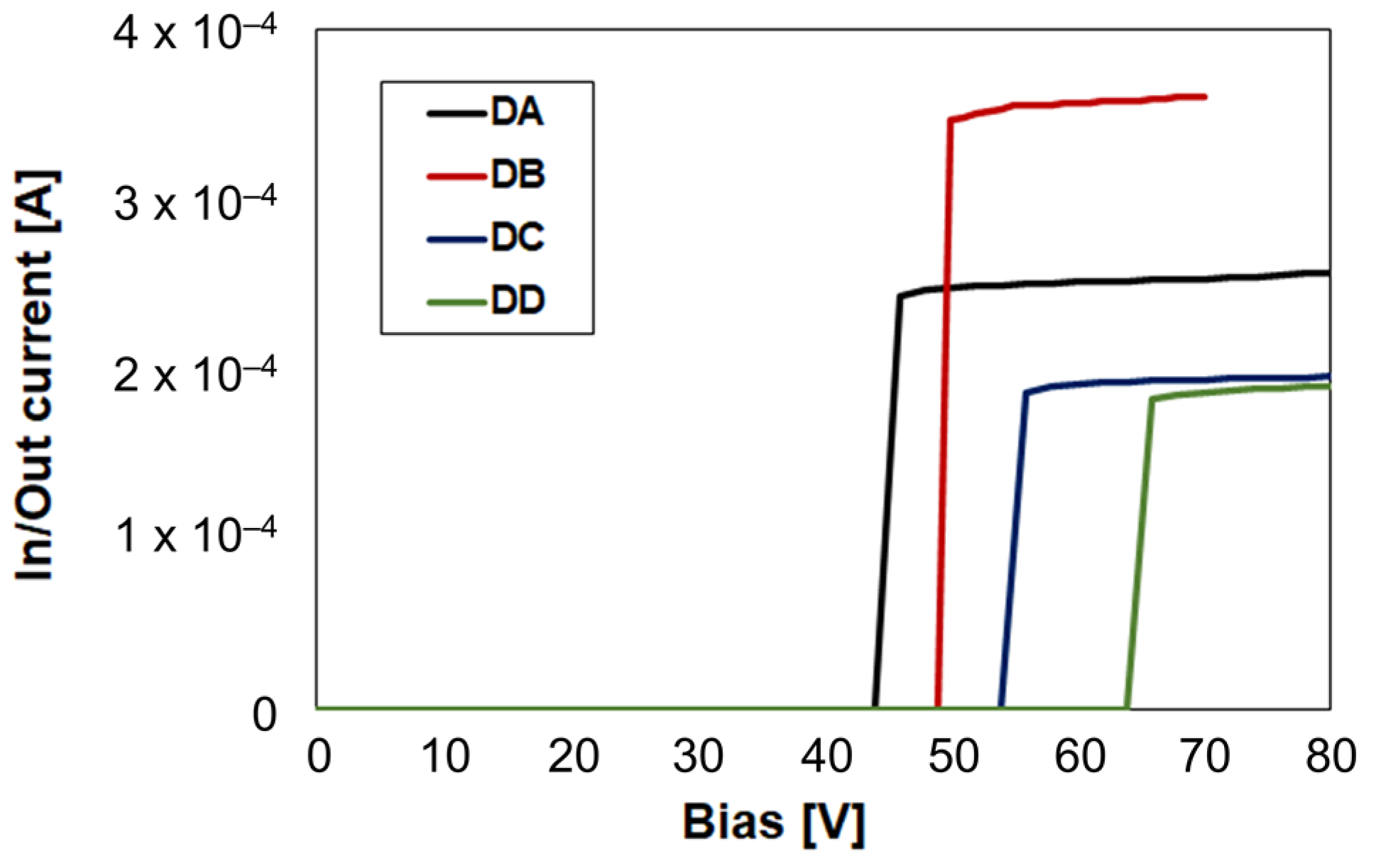
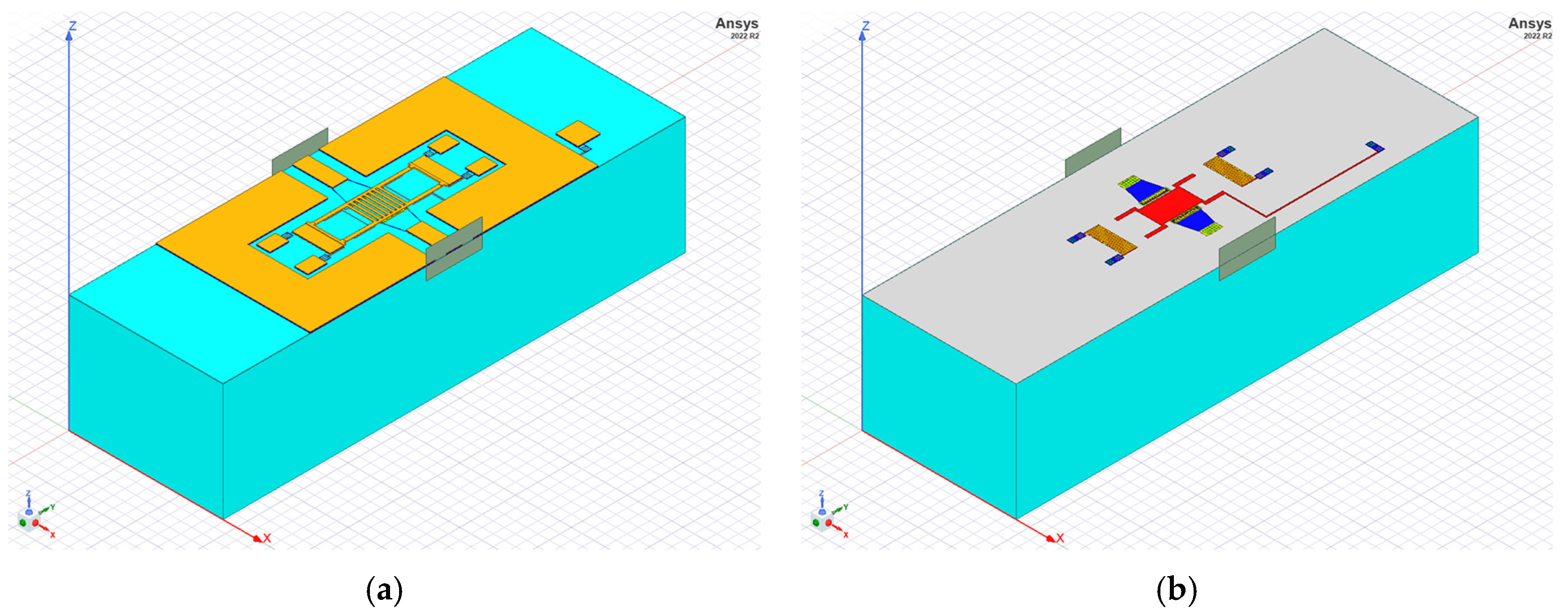


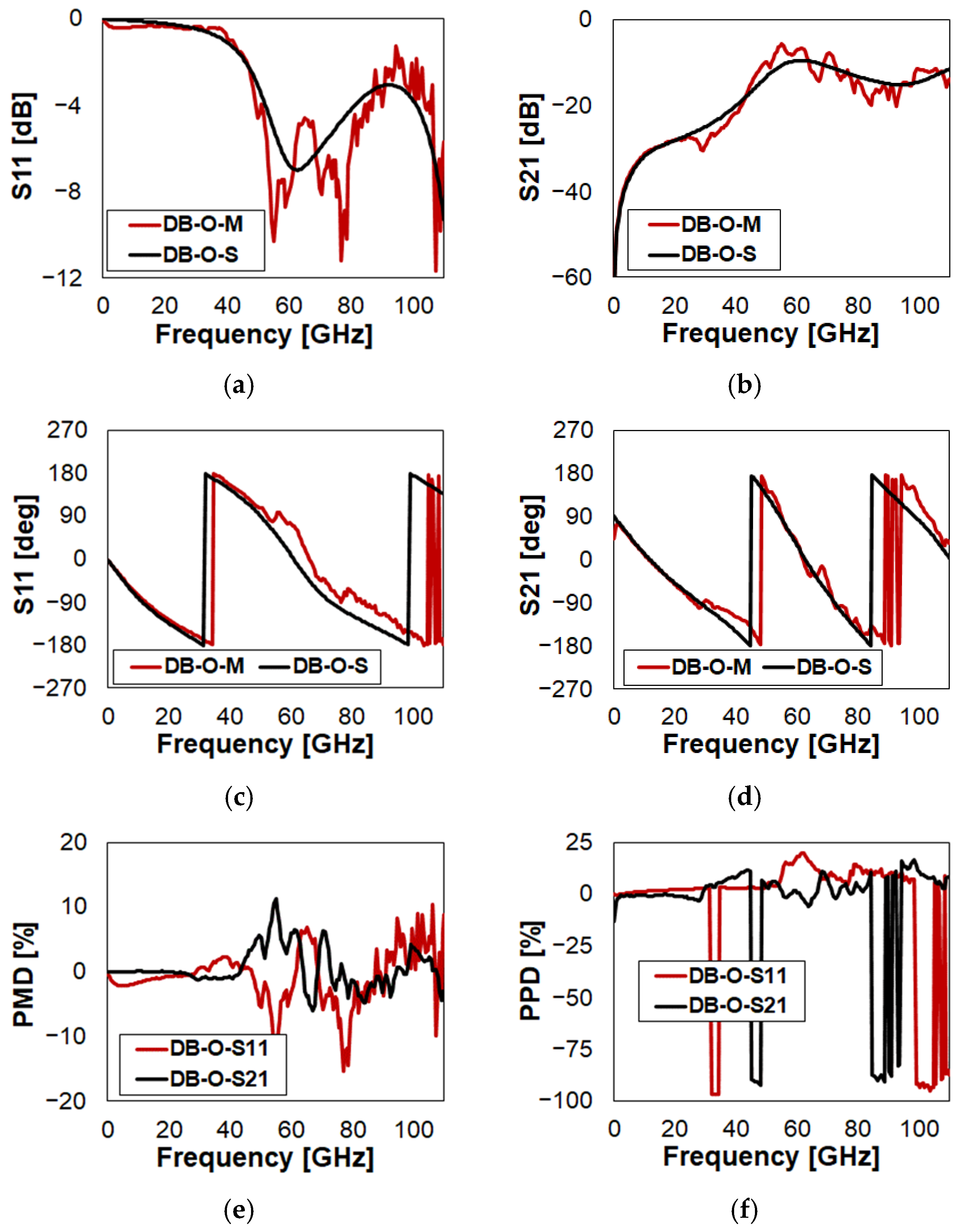
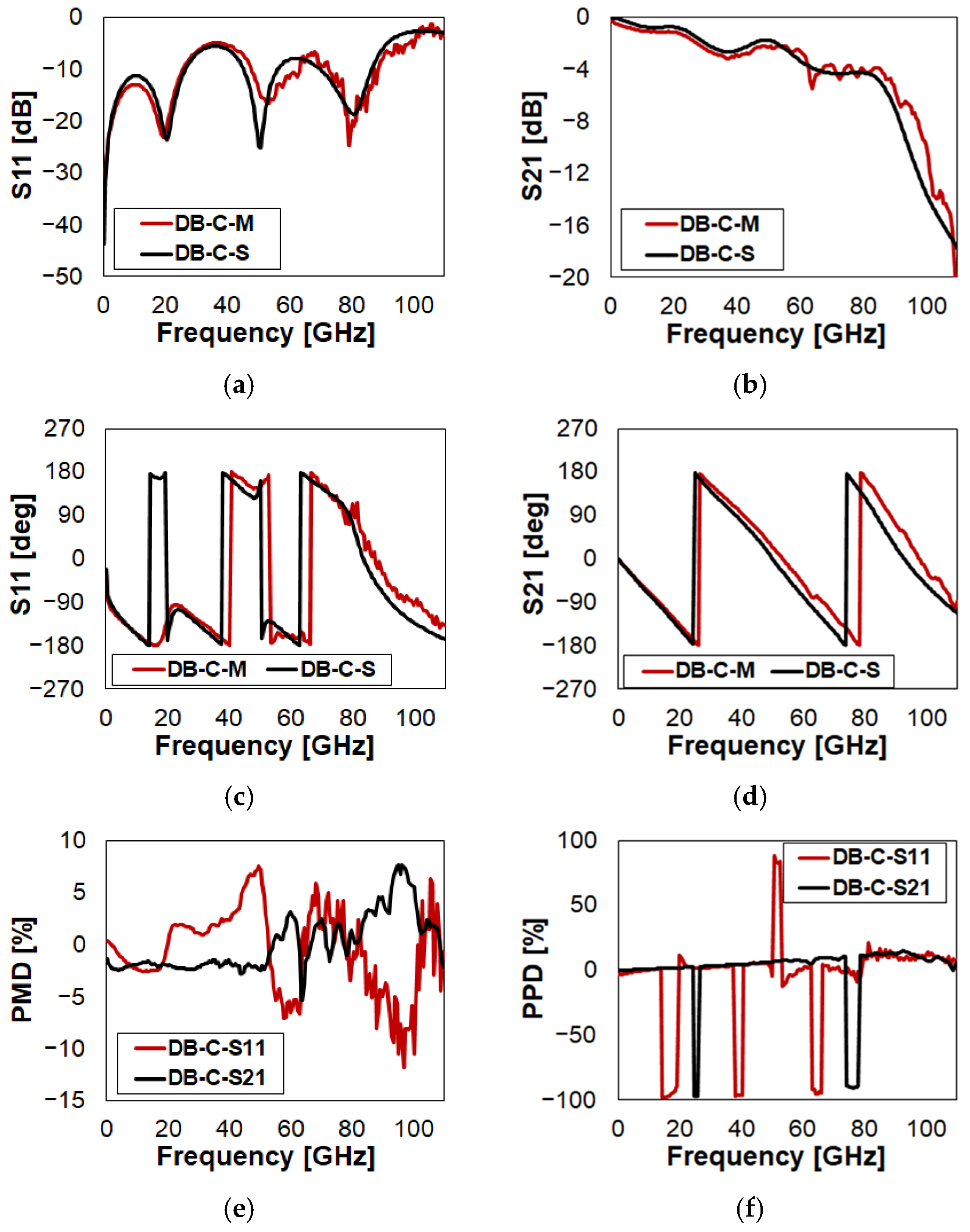
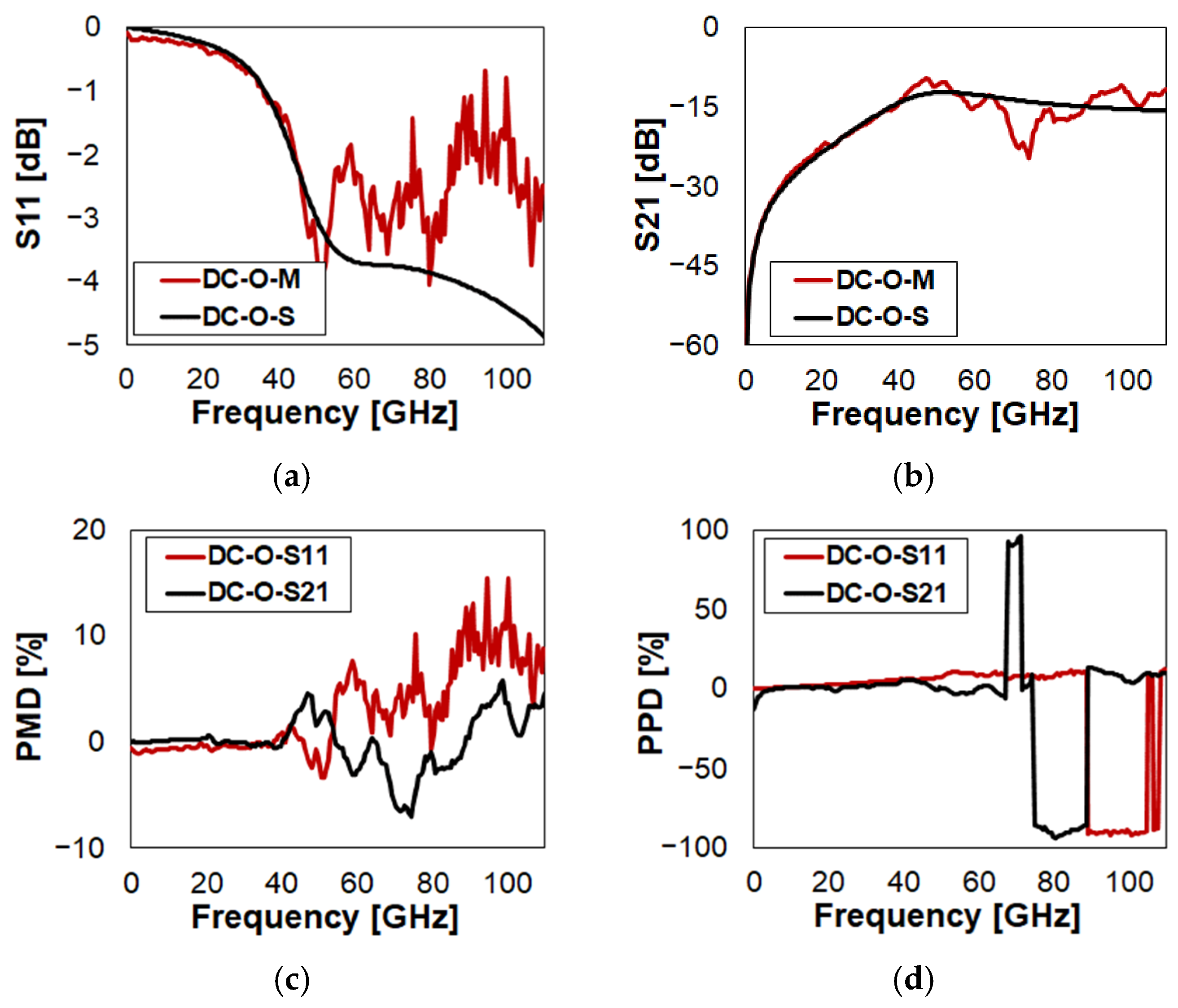

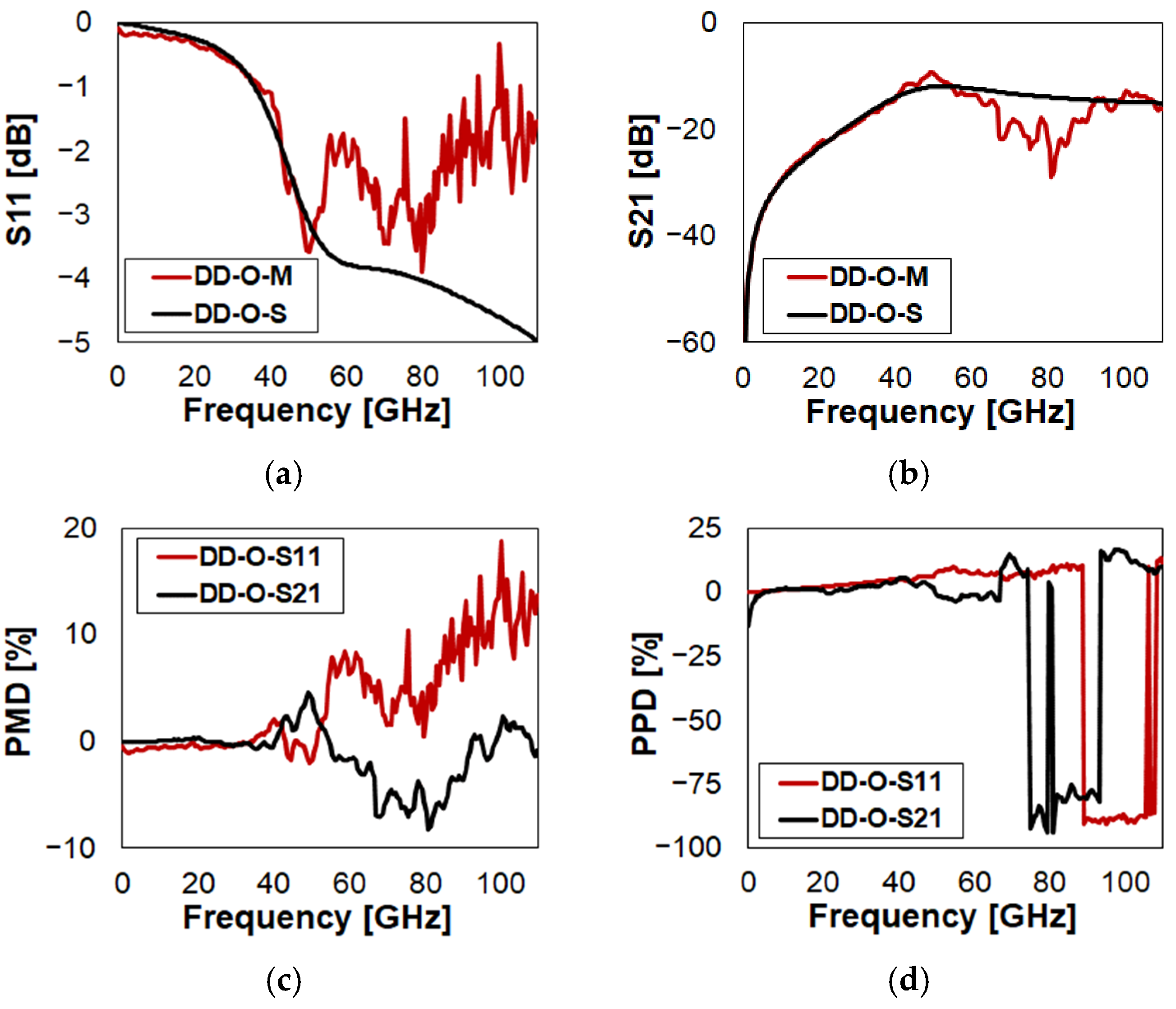

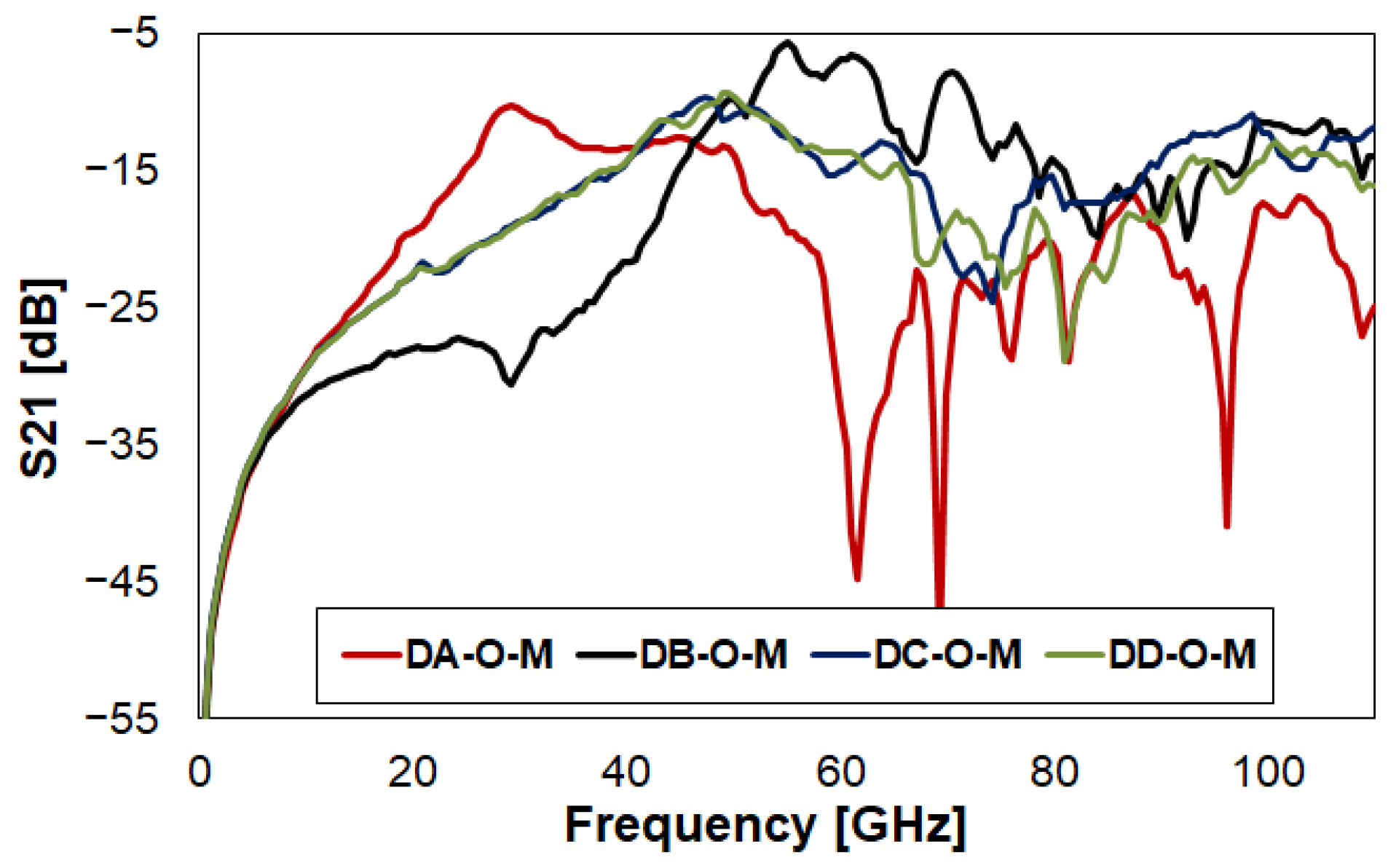
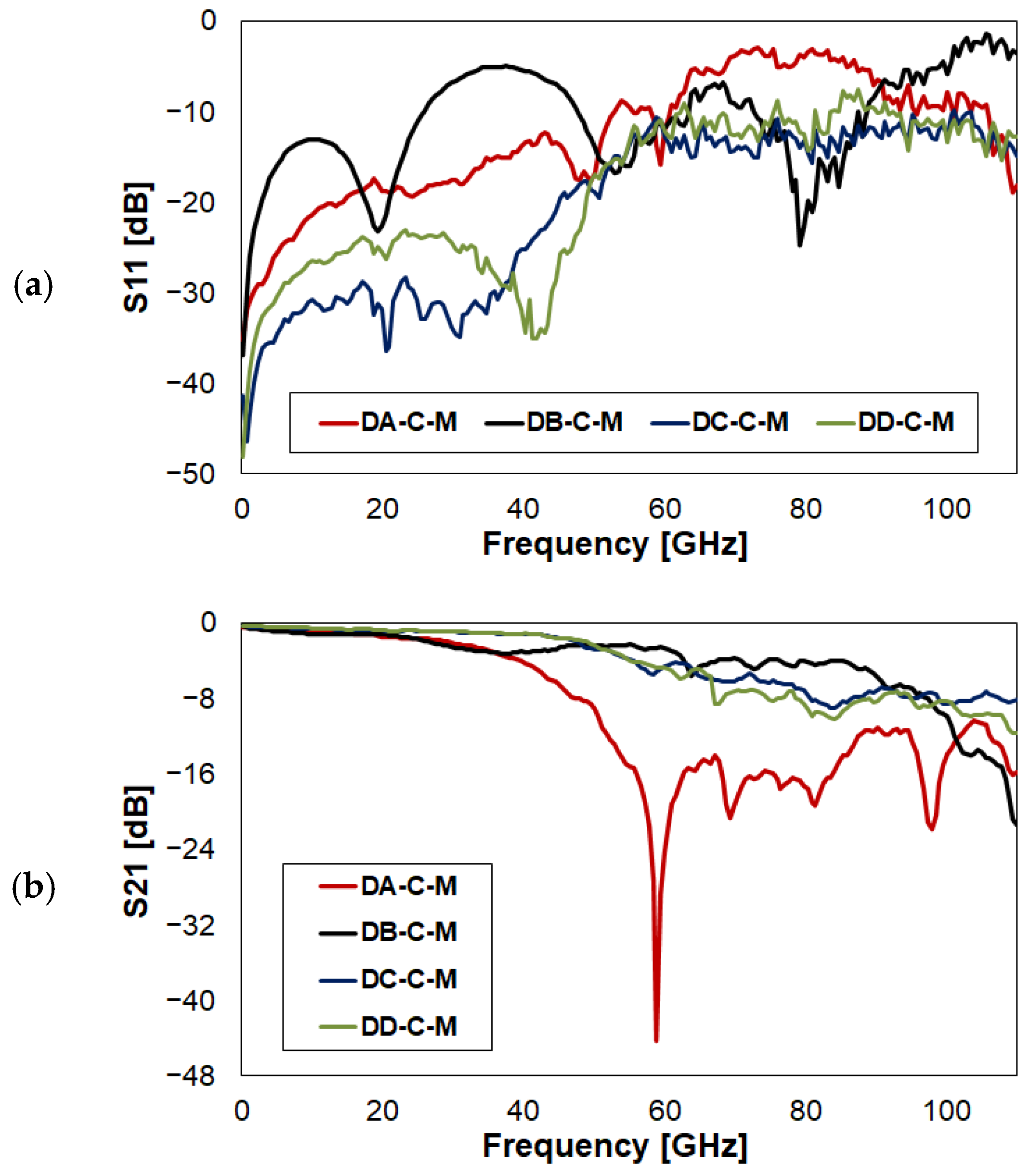
| Acronym | Meaning |
|---|---|
| DA | Device A |
| DB | Device B |
| DC | Device C |
| DD | Device D |
| C | Close |
| O | Open |
| M | Measurement |
| S | Simulation |
| PMD | Percent Magnitude Difference |
| PPD | Percent Phase Difference |
| Dev. | Description | Isolation (S21) [Open] | Return Loss (S11) [Close] | Insertion Loss (S21) [Close] |
|---|---|---|---|---|
| [33] | Radial RF-MEMS switch (electrostatically actuated) | <−8 dB up to 50 GHz | Not reported | >−0.6 dB up to 50 GHz |
| [34] | Cantilever-type electrostatic switches in a Single Pole 9 Throw structure (simulated results) | −17 dB at 60 GHz | −15 dB at 60 GHz | −0.4 dB at 60 GHz |
| [35] | Lateral comb-drive electrostatic actuators (bulk micromachining) moving above a CPW on glass substrate | <−27 dB in the range 50–110 GHz | <−17 dB in the range 50–110 GHz | >−2.3 dB in the range 50–110 GHz |
| [36] | Electrostatic RF-MEMS series ohmic switch (simulated results) | <−21.5 dB in the range 75–110 GHz | <−6.5 dB in the range 75–110 GHz | >−2.4 dB in the range 75–110 GHz |
| [37] | Electrostatic RF-MEMS shunt capacitive clamped-clamped switch (simulated results) | <−20 dB in the range 20–40 GHz | <−18 dB up to 40 GHz | >−0.3 dB up to 40 GHz |
| [38] | Lateral comb-drive electrostatic actuators (bulk micromachining) moving above a CPW on glass substrate | <−20 dB in the range 50–110 GHz | Not reported | >−16 dB in the range 50–110 GHz |
| [39] | Laterally driven RF-MEMS switch actuated by thermoelectric coupling, realized in a surface micromachining process | <−30 dB up to 40 GHz | <−20 dB up to 40 GHz | >−1 dB up to 40 GHz |
| DA | This work (see Figure 1a) | <−15 dB up to 25 GHz and in the range 50–110 GHz | <−10 dB up to 60 GHz | >−3 dB up to 35 GHz |
| DB | This work (see Figure 1b) | <−15 dB up to 45 GHz | <−10 dB up to 24 GHz | >−4 dB up to 60 GHz |
| DC | This work (see Figure 1c) | <−15 dB up to 40 GHz | <−10 dB up to 110 GHz | >−1 dB up to 40 GHz >−3 dB up to 52 GHz |
| DD | This work (see Figure 1d) | <−15 dB up to 40 GHz | <−10 dB up to 110 GHz | >−1 dB up to 40 GHz >−3 dB up to 52 GHz |
Disclaimer/Publisher’s Note: The statements, opinions and data contained in all publications are solely those of the individual author(s) and contributor(s) and not of MDPI and/or the editor(s). MDPI and/or the editor(s) disclaim responsibility for any injury to people or property resulting from any ideas, methods, instructions or products referred to in the content. |
© 2023 by the author. Licensee MDPI, Basel, Switzerland. This article is an open access article distributed under the terms and conditions of the Creative Commons Attribution (CC BY) license (https://creativecommons.org/licenses/by/4.0/).
Share and Cite
Iannacci, J. Modelling, Validation and Experimental Analysis of Diverse RF-MEMS Ohmic Switch Designs in View of Beyond-5G, 6G and Future Networks—Part 1. Sensors 2023, 23, 3380. https://doi.org/10.3390/s23073380
Iannacci J. Modelling, Validation and Experimental Analysis of Diverse RF-MEMS Ohmic Switch Designs in View of Beyond-5G, 6G and Future Networks—Part 1. Sensors. 2023; 23(7):3380. https://doi.org/10.3390/s23073380
Chicago/Turabian StyleIannacci, Jacopo. 2023. "Modelling, Validation and Experimental Analysis of Diverse RF-MEMS Ohmic Switch Designs in View of Beyond-5G, 6G and Future Networks—Part 1" Sensors 23, no. 7: 3380. https://doi.org/10.3390/s23073380
APA StyleIannacci, J. (2023). Modelling, Validation and Experimental Analysis of Diverse RF-MEMS Ohmic Switch Designs in View of Beyond-5G, 6G and Future Networks—Part 1. Sensors, 23(7), 3380. https://doi.org/10.3390/s23073380





